Gemantus: caring for a flower at home, all about planting and reproduction
Gemantus is a fairly frequent guest on the windowsills of indoor plant lovers. However, few know its official name. Popular names for this flowering perennial are deer tongue, elephant ear. This perennial flower is called so because of the shape of its leaves.
The article will be devoted to the details of caring for Gemantus growing at home.
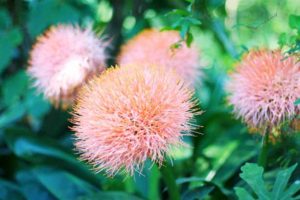
Content
Origin, description of appearance, distribution area
This flowering perennial was first described almost two centuries ago by the Swedish botanist Carl Linnaeus.And at the end of the last century, about 20 varieties of Gemantus were isolated into a separate Amaranth family.
By the way! Translated from Greek "Gemantus" means "Bloody flower".
Description of Gemantus:
- Gemantus belongs to the monocotyledonous bulbous plants.
- Until Gemantus begins to bloom, it is very similar in appearance to amaryllis. In both plants, the bulbs produce 2-3 pairs of opposite leaves. Their foliage is elongated, widened at the oval ends. It usually hangs down on opposite sides of the flowerpot.
- The deer tongue has no more than 6 leaves, and new foliage grows when the old one dies off. Only a couple of leaves are renewed annually. The bulb of this plant, in the shape of an egg or pear, is usually planted completely in the ground.
- The flowers are collected in umbrella-shaped inflorescences - small red flowers, stamens grow from each, larger in size. Less commonly, white flowers appear in the elephant ear.
- Each inflorescence is framed by bracts of the same color with flowers, there can be from four to 7-8 pieces.
- Blooming Gemantus does not have a very pleasant aroma.
- Each plant has the ability to self-pollinate, and this is a valuable quality for a houseplant.
- After the end of flowering, fruits are formed on the peduncles - berries of white, pink, orange or red colors, with a radius of up to 0.5-1.0 cm, with a characteristic odor. The first buds appear in the first decade of July, and flowering continues until the end of summer.
- And in the second decade of September, fruits begin to set on the peduncles. They fully ripen only by the end of November - the beginning of December, then the fruit pods acquire a characteristic orange color with a red tint. Ripe seeds are usually harvested and used to grow new flowers.
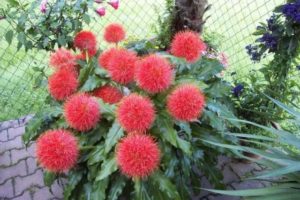
Under natural conditions, the deer tongue grows in the tropical regions of the African continent. You can meet him on the slopes of the mountains, as well as in the forests of the tropics.
Caring for Gemantus at home is not difficult, and even a novice florist can handle such a task. And if you buy different varieties of elephant ear, then a mini-greenhouse of beautiful decorative flowering indoor plants will appear on the windowsill.
Varieties
Currently, more than 35 varieties of this houseplant Gemantus are known. Only a few varieties are most popular with indoor plant lovers, and they also have many reviews:
Hemantus white-flowered
This type is the most common of all indoor varieties. An adult plant can produce 4-5 peduncles, on which large white inflorescences bloom. The foliage is broad and fleshy. The first peduncles appear in the first decade of August, and flowering ends at the end of January. All inflorescences are wrapped in wide bracts of the same color as the flowers.
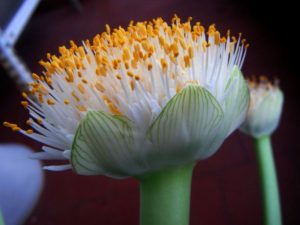
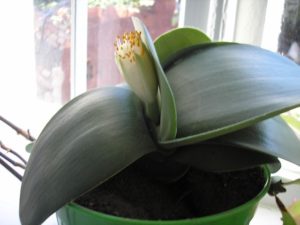
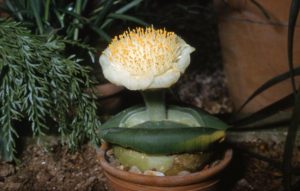
Hemantus pomegranate
The main difference between this species is that the foliage is narrow, long with wavy edges. The inflorescences are yellow with a red tint, and the stipules are green.
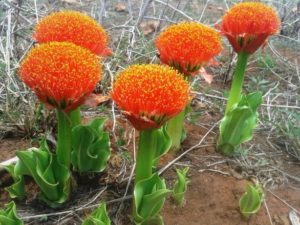
Gemantus Katarina
This is another type of "elephant ear" that is popular with indoor plant lovers. This type of "elephant ear" has a fleshy thick stem with narrow, elongated foliage growing in its upper part. The first flowers appear in the third decade of July. They are collected in bright red umbrella inflorescences.
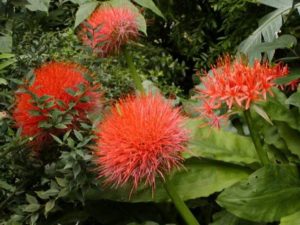
Gemantus multiflorous
At the base of this plant there are up to 6 powerful large leaves, from the middle of which a peduncle grows up to 0.6 m high. The umbrella inflorescence is very large, consisting of 70-90 small red flowers.
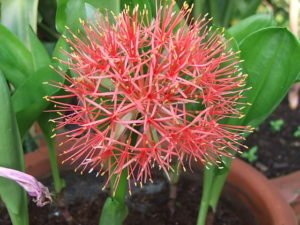
Gemantus scarlet
At the base of this plant is a pair of wide leaves, the ends of which are colored red. The peduncle grows long, its color is spotty. Umbellate inflorescence is very densely packed with small red flowers.
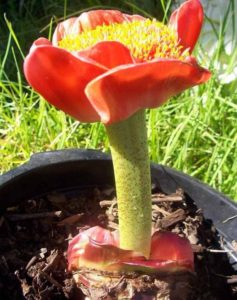
Home care for all types of Gemantus, be it White-flowered or Gemantus Katarina, is about the same.
Basic conditions for this flower
Indoor flower Gemantus for normal growth and existence requires the following conditions:
Temperature:
- In the summer - 20-22 degrees.
- In winter - 11-12 degrees.
Lighting: should be constant throughout the day.
Watering:
- In summer - regular as the soil dries.
- In winter, they are reduced to a minimum.
Air humidity: does not require regular spraying.
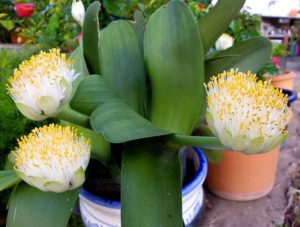
Planting and transplanting
Before planting the bulbs, you should pick up a flowerpot a couple of centimeters larger than the bulb itself. The pot is chosen so that it is large enough in width, but shallow. There must be drainage holes in the bottom of the flowerpot.
You can buy soil for planting in a specialized store - for bulb flowers.
But you can make a nutrient substrate yourself:
- Mix 2 parts of turf and 1 part each of leafy soil, peat and fine sand.
- Before planting, the substrate should be mixed and watered well.
- When planting, the bulbs must be immersed in the ground no more than 2/3.
- After planting, watering is necessary as the soil dries.
After planting, the flower pot is placed on windows facing east, west, or northeast. If you have to place the plant on the south window, then shade it from bright sunlight. And the white-flowered Gemantus feels great in light shade.
This perennial is transplanted as the bulbs grow. Usually, a transplant is carried out every couple of years. This procedure is performed either in winter, when the perennial is in hibernation, or in early spring, when the plant has not yet begun to grow.
When transplanting, you should carefully move the perennial from one flowerpot to another, so as not to damage the root system of the bulbs. Otherwise, the flower will hurt for a long time. Between replanting, replace the topsoil in the pot.
Note! After transplantation, the rules for caring for a flowering perennial do not change.
Home care
Although this plant came from tropical forests, it does not require any special conditions for growth. It feels great in indoor conditions.
But still, despite its unpretentiousness, the Gemantus flower requires some care at home. There are certain nuances in caring for this flower, and if the owners forget about it, then the plant can get sick, not start flowering.
Therefore, before purchasing such a flowering perennial, you should familiarize yourself with the basic rules and maintenance and care of a deer tongue flower in an apartment or office space.
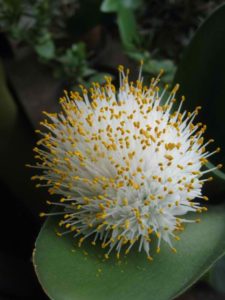
So, how to take care of Gemantus at home will be described later.
Watering and feeding
In the summer, this plant should be watered in moderation, if the remaining water is drained into the pan, it should be drained. Subsequent watering is done when the topsoil dries up.
Important! The plant is not afraid of a short period of drought - this is less harmful to the flower than abundant watering.
The indoor flower Gemantus is undemanding to air humidity, so there is no need to moisturize its foliage. In winter, watering of evergreen varieties of Gemantus is reduced. But those plants that "go into hibernation" do not need to be watered, just slightly moisten the soil in the pots.
Top dressing should be applied to the soil no more often than once every 14-20 days in the spring-summer period, when the plant is actively growing and begins to bloom. Usually, fertilizers containing organic matter or mineral fertilizers are used in turn.
By the way! In the autumn-winter period, these perennials do not require additional feeding.
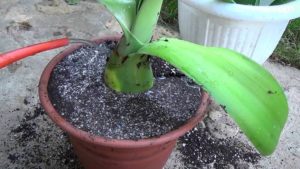
Flowering features
It happens that this perennial does not bloom for too long. Therefore, many growers ask the question "Why does not Gemantus (white-flowered or any other) bloom at home and what to do in this situation?"Experienced growers are sure that the reasons for this may be:
- insufficient watering of the plant;
- the plant did not rest during the winter;
- too high room temperature in winter.
Therefore, if the plants do not begin to bloom on time, and the growth of foliage has also slowed down, the above reasons should be eliminated. And the plant will soon throw out flower stalks.
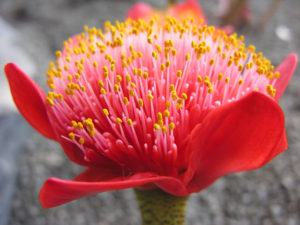
Caring for the "elephant ear" during the flowering period consists in regular moderate watering and the introduction of mineral and organic dressings every two to three weeks.
After the end of flowering, you should wait until the fruits ripen on the peduncles (if the growers plan to use the collected seeds for further reproduction). Otherwise, the peduncle can be removed at the end of flowering.
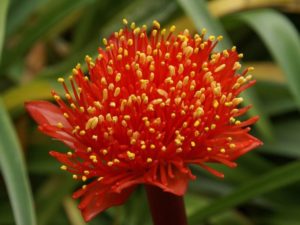
Dormant period
Most varieties of this flowering perennial have a period in which they rest from flowering and growth - a period of complete rest. Usually these flowers “hibernate” from early October to late February. At the beginning of autumn, the number of watering should be reduced, foliage should be removed as it dries. In winter, these flowers should be placed in a cool dark room with an air temperature of 13-15 C. The soil should be slightly moistened.
In the last decade of February, pots with Hemantus houseplants are returned to their original place, transplanted (if necessary) or the topsoil is replaced. You should also start to water the plant in the "summer" mode.
Diseases and pests
| Name of the disease (pest) | Way to fight |
| Shield | First, most of the insects are removed with a brush, then sprayed with rogor or karbofos |
| Red spider mite | The foliage is washed with warm water, then treated with insecticides |
| Fungal diseases | Removal of damaged foliage, treatment with special agents |
Pests most often infect plant foliage by sucking nutrients from the leaf cells. As a result, the foliage begins to dry, turn yellow, and then simply fall off.
Although this flower little susceptible to various diseases, but still sometimes he can get sick. The main reason for this is improper plant care.
If the plant is watered too often and abundantly, then the underground part of it may begin to rot. This is often the cause of root rot in Gemantus. Ensure correct application of moisture to the soil and provide adequate lighting.
The appearance of a gray bloom on the foliage indicates that the water for irrigation is too hard - it is necessary to defend and filter it in advance. If the foliage turns yellow during the summer season, then the flower is getting too much light.
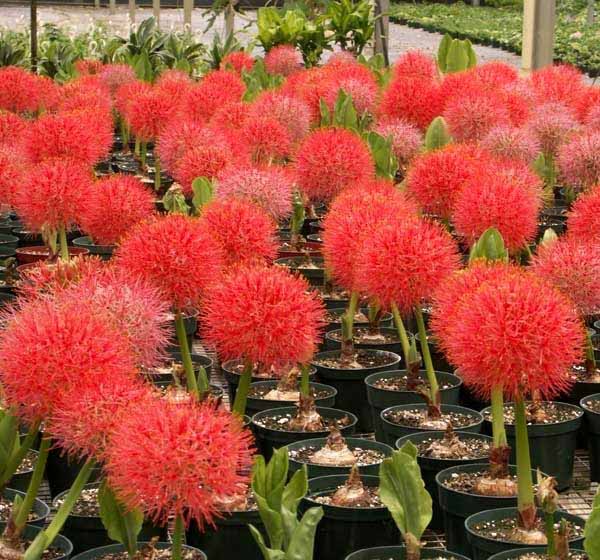
Reproduction
The indoor flower Gemantus can be propagated in several ways:
- seed material;
- foliage cuttings;
- daughter bulbs.
It is quite easy to get young plants using any of these methods, and each grower will choose the most suitable breeding method for this flowering perennial.
Propagation using child bulbs
Small bulbs are formed next to the main bulb after a year or two. Usually they are separated from the mother bulb at the next plant transplant and planted in separate containers. Young plants will grow for at least 3 years before flowering.
Seed propagation
When propagating this perennial with seed, it should be remembered: their seeds quickly lose their germination. Therefore, it is better to use seeds collected this season for planting. Planting and growing seedlings does not differ from reproduction by this method of other indoor plants.
Propagation by cuttings of leaves
For this type of reproduction of Gemantus, external strong leaves should be separated, which are attached directly to the bottom. The cut site is usually treated with charcoal.
The cut foliage is first dried and only then planted in containers filled with a mixture of high-moor peat and river sand.Small bulbs soon grow at the base of the leaves. They are carefully separated and planted in pots, where young plants will grow further.
As mentioned, the cultivation of these flowering perennials does not require much effort from the growers. And the beautiful decorative appearance of the Hemantus indoor plant will be a bright addition to the interior of an apartment or office space, it is enough just to follow the simple rules of home care.

